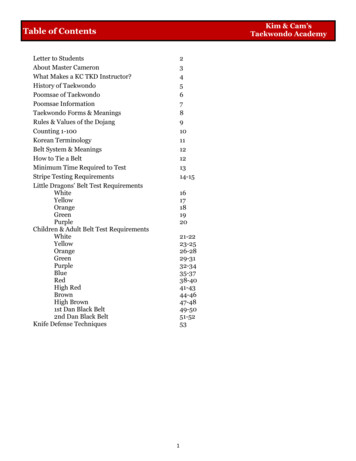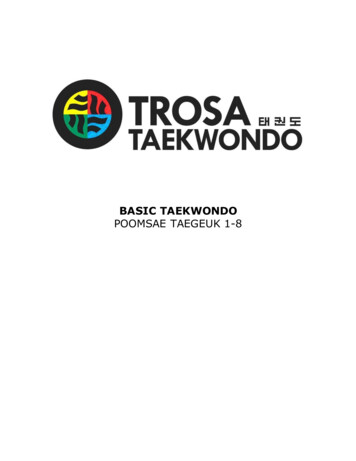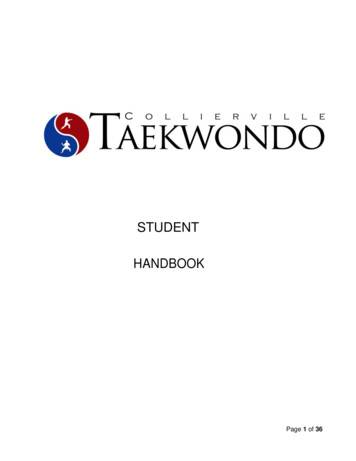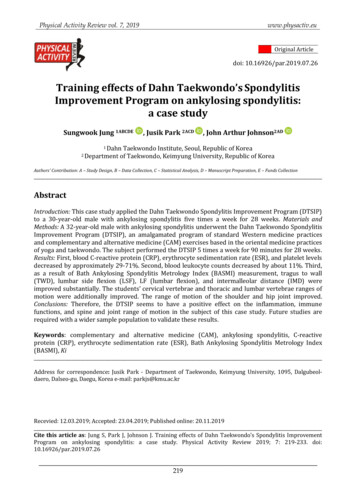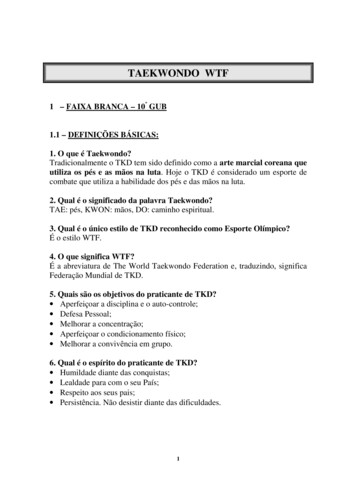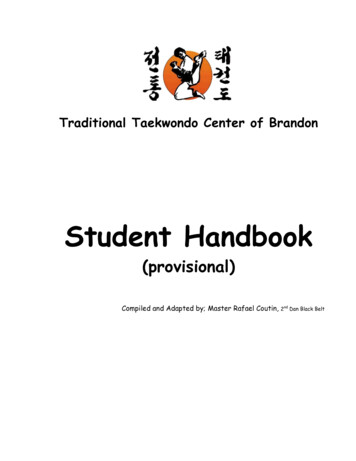
Transcription
OLYMPIC TAEKWONDO PROGRAMSTUDENT HANDBOOK & CURRICULUM GUIDEby Shawn L Hill
CONGRATULATIONS!You’ve decided to take the plunge, learn something new, or maybe you’re just getting back into training. Either way registeringfor classes is the first step to achieving great things. Now let’s get you informed about our Olympic Taekwondo Program.This curriculum guide / student handbook wascreated to help give you a decent idea of what toexpect and what is expected within the program,though nothing is ever written in stone when itcomes to martial arts systems. They are dynamic,always changing, and ever improving. Taekwondois a good example of this dynamic change.The best way to utilize the information in thisbooklet is as a basic guide; a framework if youwill that defines the structure and outlines theprocess of learning Olympic Style Taekwondo.Techniques can be altered, movements tweakedand requirements modified over time. Manyinstructors of martial arts systems would noteven dream about giving studentsdocumentation of any kind for curriculum. Thosesystems rely solely on instruction from a teacheror master and the student’s knowledge is gainedonly through this interaction.There is nothing wrong with that process. In fact,that way of teaching has served a lot of people very well over the years. For this program however, in this modern age ofdistraction, I feel it might serve to aid in the study for those students living truly busy life styles. Now, there is no substitute fordedication let’s get that out there. Anyone wanting to learn a martial arts system must dedicate time and effort to the studyand practice. Otherwise it’s not going to happen.It’s my intention to provide you with an edge, a guide that you can reference on the go to help you practice when you have aspare moment at hand. The next pages in this booklet will define the customs, etiquette, and basic requirements for thisprogram to be used as a supplemental guide on top of learning directly from the program’s instructor. If used properly, it shouldhelp make your learning process that much better of an experience.Not all programs and systems are run exactly the same. If you are transitioning from another school, club, program to thisprogram or find yourself transitioning from this program to another school, you will experience differences in curriculum,etiquette, customs and structure. Don’t worry too much about that, the basics are the basics but each program and school tendto become personalized by the lead instructor.This program follows some of the basic customs and etiquette but not all and maybe not exactly the same way others do. Youwill adapt quickly, trust me
A FEW WORDS OF ADVICE BEFORE YOU BEGIN THE JOURNEY TO LEARN TAEKWONDO:REMEMBER, this is for you so don’t cheat yourself! Always push to give 100% during training and practice. This may seem like generic advice,but understand when folks become involved with structured programs, of any kind, they tend to become creatures of habit and may do justenough to get by or complete a task. That’s not how it works in martial arts. You have to go beyond just getting by and beyond gettingsomething good enough. Techniques are learned and then tweaked and refined over years and years of practice. Remember you’re not doingthis to pass a test or to get a belt; you’re doing this to learn the art period!Practice at home and attend class as often as possible. The skills learned in any martial arts system need lots of attention and therefore youneed to put aside a lot of practice time. Supplement every hour of class time with at least one or more hours of practice on your own.Honestly, for serious practitioners, one hour of class equals 4 or more hours of extra practice outside of class. DO NOT rely on classes alone.The classes are guides much like this booklet. A skill is taught and you must practice it.Don’t feel silly or stupid carrying out the etiquette and customs recognized by the system. You may feel odd at first saying yes sir or noma’am to another person, unless of course you come from a military background. It may seem goofy to bow to another individual, a room, orto a group of people you don’t know yet, but keep in mind that the etiquette and customs are followed for the purpose of fostering arespectful learning environment for everyone. Without this expected behavior, it would be next to impossible to run large classes where eachperson can hear instruction or see how to do something. Do not mistake respect for submissiveness. When you bow to another person, youare not pledging your obedience; you are acknowledging a respect for that individual. That’s it.Last, but not least, READ THIS WHOLE BOOKLET!
TABLE OF CONTENTSTAEKWONDO - KNOW YOUR ART!VOLUNTEERING – COMMUNITY SERVICE & THIS PROGRAMTHE ETIQUETTE WE OBSERVE – WHY IT MATTERSTENETS OF TAEKWONDO – THE FIVE CODES OF HUMAN CONDUCTUNIFORMS – THE REASON WE WEAR THEMBELT RANK COLORS – BEGINNER TO ADVANCEDHOW TO TIE THAT NIFTY BELTLINING UP - BEFORE & AFTER CLASSOPENING & CLOSING CEREMONY FOR CLASSESTESTING & PROMOTION – ALL THOSE COOL BELT COLORSPOOMSAE – WHAT’S THAT?SPARRING – LOOKS SCARY, DO I HAVE TO?STEP SPARRING – BUT WHY?SELF DEFENSE – AM I A KILLING MACHINE YET?BREAKING – NOW WE’RE TALKINGSTRETCHING – YES, IT’S A MUST!COMPETITION – LET’S DANCE!THE BEGINNING - 10th GEUP - WHITE BELT
TAEKWONDO - KNOW YOUR ART!So, you’re going to be learning Olympic Style Taekwondo?Just what is Taekwondo? Secondly, what is Olympic StyleTaekwondo? What does the word Taekwondo mean?Where does Taekwondo originate from and how old is it?To answer those questions and a whole lot more I grabbedthe actual description from the formal organization thatgoverns the style of Taekwondo taught through thisprogram, The World Taekwondo Federation known as TheWTF.“Taekwondo is one of the most systematic and scientificKorean traditional martial arts, that teaches more thanphysical fighting skills. It is a discipline that shows ways ofenhancing our spirit and life through training our body andmind. Today, it has become a global sport that has gainedan international reputation, and stands among the officialgames in the Olympics.Let's take a closer look at the meaning of the word "Tae" "Kwon" "Do." It is composed of three parts as shown in the Englishspelling, though it is one word in Korean. "Tae" means "foot," "leg," or "to step on"; "Kwon" means "fist," or "fight"; and "Do"means the "way" or "discipline." If we put these three parts together, we can see two important concepts behind "Tae Kwon Do".First, Taekwondo is the right way of using Tae and Kwon 'fists and feet,' or all the parts of the body that are represented by fistsand feet. Second, it is a way to control or calm down fights and keep the peace. This concept comes from the meaning of TaeKwon 'to put fists under control' [or 'to step on fists']. Thus Taekwondo means "the right way of using all parts of the body to stopfights and help to build a better and more peaceful world."Taekwondo has been developing with the 5000-year long history of Korea, being called by several different names in the course.In Korea, Taekwondo began as a defense martial art called "Subak" or "Taekkyon," and developed as a way of training body andmind in the ancient kingdom of Koguryo, under the name of "Sunbae." In the Shilla period, it had become the backbone ofHwarangdo that aimed at producing leaders of the country.Taekwondo today is similar to the martial arts in other Oriental countries and shares some features with them, because in thecourse of its evolution it has gained many different styles that existed in the martial arts of the countries surrounding Korea, likeJapan and China. But Taekwondo is very different from many such oriental martial arts. First, physically it is very dynamic withactive movements that include a mirage of foot skills. Second, the principle physical movements are in simpatico with that of themind and life as a whole. Third, it possesses dynamic poses from another perspective.Taekwondo can be characterized by unity: the unity of body, mind, and life, and the unity of the pose "poomsae" andconfrontation, and cracking down. When you do Taekwondo, you should make your mind peaceful and synchronize your mindwith your movements, and extend this harmony to your life and society. This is how in Taekwondo the principle of physicalmovements, the principle of mind training, and the principle of life become one and the same. On the other hand, the rightpoomsae lead to the right confrontation, which will eventually produce great destructive power.How come we reach such a unity in Taekwondo? Taekwondo is a way of life, much like having a job, raising a family, fighting fora cause, or any one of numerous raison d'etre. What makes Taekwondo different from these is that it is an activity for survival inextremely antagonistic situations. One must always overcome the enemy that is trying to cause harm. But simply winning a fightis not enough to guarantee one's safety, because the enemy may recuperate and attack again. Moreover, there may be many
other enemies than the one that was just defeated. One cannot ever feel safe unless one gains permanent peace. To attain thispermanent or lasting peace, one needs unity. This is what Taekwondo aim for. Otherwise Taekwondo would be no different fromany other street-fighting skills.Taekwondo pursues harmonious growth and improvements of life through its unique activities. This is why one could sayTaekwondo is a way of life. To ultimately enable ourselves to lead more valuable lives, we would do well by finding the guidingprinciples deeply hidden in Taekwondo.”“There are two main branches of taekwondo development, which are not necessarily mutually exclusive: "Traditionaltaekwondo" typically refers to the martial art as it was established in the 1950s and 1960s in the South Korean military, and invarious civilian organizations, including schools and universities. In particular, the names and symbolism of the traditionalpatterns often refer to elements of Korean history, culture and religious philosophy. Today, the Kukkiwon, or World TaekwondoHeadquarters is the traditional center for Taekwondo in Korea."Sport taekwondo" has developed in the decades since the 1950s and may have a somewhat different focus, especially in termsof its emphasis on speed and competition (as in Olympic sparring). Sport taekwondo is in turn subdivided into two main styles;one derives from Kukkiwon, the source of the sparring system, sihap gyeorugi, which is now an event at the summer OlympicGames and which is governed by the World Taekwondo Federation (WTF). The other comes from the International Taekwon-DoFederation (ITF).”This program covers WTF Olympic style taekwondo with 50 percent of the curriculum geared towards gaining traditionalskillsets, (forms, self-defense, blocks, strikes, etc.), and 50 percent towards the Olympic sport training, ( kicking drills, footwork,sparring, and competitions). This provides a good balance between the art aspects of taekwondo and what is considered themodern sport aspect. Also, always keep in mind that within the world of martial arts there are many styles and within each art,such as TAEKWONDO, there are many variations of that style. Not everyone learns or teaches by the same exact methods. Noteveryone teaches or learns the same exact techniques and not everyone teaches the same exact way. As we said before, themartial arts systems are very dynamic and change or become personalized by those who oversee them.
VOLUNTEERING – COMMUNITY SERVICE & THIS PROGRAMHomes For Our TroopsEvent in Bangor, MEAugust 2013Volunteering is a concept that some may think of when doing a nice deed once in a while. Maybe volunteering to help aneighbor take their trash to the curb or volunteering to picking up a friend whose car broke down. Perhaps you’ve volunteeredto let someone borrow money you’ll most likely never see again. Although those are all very nice things to do for someone andthey might fall under the category of “informal volunteering”, they don’t constitute the type of volunteering we’ll be exploring inthis guide and that will be required for this program.Overall, volunteers play a huge role in helping to create healthy communities and in many cases volunteer involvement is crucialfor a community’s ability to exist, succeed and thrive. Without those everyday volunteers dedicating time and effort to addressneeds within their own neighborhoods, towns, cities, states or even the entire country they live in, the world might be a verydifferent place.So, how does volunteering relate to learning Olympic Style Taekwondo and this program? That’s easy to answer MARTiAL YOUis a nonprofit organization dedicated to community involvement and awareness. Our mission to promote the benefits of martialarts goes hand in hand with promoting community responsibility through community awareness. Having students get involvedwith charitable activities can help drive a sense of respect for others, the work they do, and the impact they have on the entirecommunity.As part of our efforts to reach out and help give back, we have integrated volunteer requirements for those enrolling in themartial arts program. Students who wish to test and receive promotion to the next rank must contribute a preset number ofvolunteer hours to a local charitable organization before doing so.
MARTiAL YOU will be working tocreate collaborations with localcharities in order to create aconsistent base of opportunities fromwhich students can choose todedicate their time and to make iteasier for them to get started.However, students will not be limitedto charities working directly withMARTiAL YOU, and may choose tovolunteer their time with any localcharity holding a 501c3 status.Students and parentsvolunteering time to fix-upa run down room used forclasses. June 2013Now, finding time to volunteer these days doesn’t seem to be all that easy. So many things to do, not enough time, and plenty ofdistractions keep a lot of us teetering more towards the edge of “I can’t do it right now.” This is a completely understandabletrain of thought, and I for one have battled with this three part balance scale of “what I need to do”, “what I should do”, and“what I want to do.” Also, a common misconception that may discourage some is that volunteering will take up all their freetime. This of course is just not true. The time dedicated to any volunteering is completely up to you. It can be as little as thirtyminutes a month or as much as eight hours a day or anything in between. You decide.THE IMPORTANCE AND IMPACT OF VOLUNTEERINGAccording to the annual Volunteering and Civic Life in America research by the Corporation for National and Community Serviceand the National Conference on Citizenship, including stats from The National Bureau of Labor, it’s estimated that approximately25.3 percent of US citizens volunteered through or for an organization at least once in 2013. That’s about 62.8 million peoplewho decided to give away some of their precious time for a cause. Roughly 7.7 Billion hours were donated by volunteers, andthose hours tallied up to a value of about 173 billion dollars based on the Independent Sectors estimate of the average value ofa volunteer hour.In addition, more than 138 million Americans (62.5 percent) also engaged in “informal volunteering” in their communities,helping neighbors with such tasks as watching each other’s children, helping with shopping, or house sitting. Other civic healthindicators from the report found that two-thirds (68.5 percent) of Americans have dinner with their family virtually every day,while three in four (75.7 percent) see or hear from friends and family at least a few times a week, and more than a third (36.3percent) are involved in a school, civic, recreational, religious, or other organization.If those numbers alone don’t resonate just how much volunteering is part of and needed by our society, let me give you someideas about what these volunteers do.Volunteers play a critical role in society whether they are actively donating time through formal organizations, ad hocorganizations, or participating in “informal volunteering” by providing personal care for those close to them such as neighbors,family, and friends, or maybe even complete strangers, in an effort to give back.Volunteer tasks have a huge range from stuffing envelopes for an important cause to unloading a truck load of bottled water in adisaster zone and from providing home care for the elderly to piloting a plain to make sure a needy medical patient gets to adistant location for treatment.Volunteers serve communities as volunteer fire fighters, man hotlines such as those for domestic violence and sexual assaultorganizations; participate in search and rescue activities, aid in disaster relief by getting crucial supplies where they need to be,deliver meals to the homeless, and they provide help to helpless.
Volunteers serve as coaches, mentors, teachers, tutors, and counselors for all age groups, the disabled and the financiallychallenged. Volunteers in the medical profession donate time to free clinics and provide medical knowledge and aid for victimsof disasters all over the world. They work to help create public awareness for safety and health concerns.Volunteers help to repair broken infrastructure, gain access to clean water, construct houses, schools and other facilities useddaily. They work to patrol neighborhoods, parks, and streets to help keep them safe, and they are out walking dogs, takingtickets at performing arts events, giving tours at museums and organizing cultural festivals. The involvement is endless and theimportance is, well, incalculable.MARTiAL YOU’s free community Halloween Eventorganized and run by volunteers. October 2013Think about what the world would be like without all the volunteers who dedicate time and effort on a daily basis. What if those volunteersall of a sudden stopped volunteering? What would happen to our neighborhoods, towns, cities, places of worship, libraries, stateparks, and schools? What basic needs would we all have to do without? What opportunities to learn, grow, and thrive as acommunity, or as a whole society, would disappear?Volunteers are all around us and whether we know it or not, we likely meet at least one every day. They are the silentunrecognized voices, givers, and heroes that are working non-stop to make sure life is good, for all of us!Program students become part of that important force shaping the world by giving without the thought of receiving. Each testing period,depending on age and rank, those enrolled are required to provide between one and ten hours of volunteer time before promotion. It is ourintent to foster community awareness and involvement through these requirements and it is our hope that getting students involved withcharitable projects will result in them becoming better acquainted with their own local community and its needs, and perhaps may inspirevolunteering above and beyond the program requirementsRequired volunteer hours for each rank are listed on the belt requirements page.
THE ETIQUETTE WE OBSERVE – WHY ITMATTERSet·i·quette (noun)the customary code of polite behavior in society or amongmembers of a particular profession or group.Drawing upon multiple resources, including personalexperience, I’ve put together a quick guide andexplanation of etiquette. Because etiquette is literally the foundation upon which martial arts exists, and plays a huge role inevery aspect of human life, it’s important that I place the proper amount of emphasize on it. Let me start by quoting a gooddescription I was able to find regarding the meaning and purpose behind what we call etiquette.“Etiquette or "Ye" in Korean is an essential spirit in TaekwonDo training. Taekwon-Do practice must begin and end withetiquette. Ye is an abbreviation of Kyongnye. Ye denotes theway that all human beings must follow. It’s considered thefundamental base on which human spirit stands. That isrespect for humanity. Etiquette is an expression, throughactions, of one's mind respecting the other party'spersonality, constituting a lofty and valuable basic attitude ina person. A code of etiquette is aimed at encouragingTaekwondoist to behave themselves like a person ofetiquette, always trying hard to cultivate a righteous anddecent character in them so that everyone throughout theworld may follow their examples. Children especially need farmore discipline and order. The child’s overflowingenthusiasm can be tempered only through reinforced moraleducation, which starts by the training of etiquette.”“Etiquette should be based on an upright mind and modestattitude. One should get rid of mean attitudes, showing onlymodest attitudes, which is an important part of etiquette.Decent and accurate speech, graceful conduct, upright and moderate attitudes are all the essentials of etiquette deserving ahealthy modern life. Etiquette is also the source of maintaining harmony and solidarity for community life.”Since “the martial arts” are made up of systems that teach physical and mental skills to students, in groups, or one on one, theyneed to be based on a desirable learning environment that works for both the teacher and the student. Because of this need,these arts have developed a behavioral etiquette based around the tenants or core beliefs of each system. This governingbehavior encourages courtesy, humility, and respect through the entire process of learning and remains at the core of thosearts.The program you have enrolled in is no different and requires etiquette to be observed and practiced. Students must be allowedto thrive side by side, and in order to achieve this all students will be required to immerse themselves into the practice of thisetiquette. Everyone involved must address and treat each other in a courteous and respectful manor. By keeping a solidfoundation based on proper etiquette, a rewarding system is maintained that acknowledges those who work hard and helpskeep structure and order for those trying to learn. Examples describing etiquette standards can be found all over and I justhappen to have a few.
“Centuries old principles of oriental custom deem it disrespectful to sit down before one’s elder or senior sits down, or stand upbefore one’s elder or senior stands up. Traditional taekwondo classes employ examples of this type of etiquette and respectincluding: juniors always bowing prior to the senior bowing, juniors bowing lower than their senior does, rising up after the seniorrises up, as well as kneeling down and standing up after the senior. It’s also considered disrespectful to issue commands to one’ssenior. Therefore, the senior student only issues commands for the class to perform a particular motion after the instructor hasalready completed that motion.”The etiquette we observe begins as soon as you step into the training area or what’s called the dojang for taekwondo. Toencourage a respect for the dojang, the area where all students share challenges, work hard to improve upon themselves andhelp each other achieve goals, we start by acknowledging our appreciation for the art, the training space, its contents and thosewho occupy the dojang by bowing on the way in. This custom is also repeated any time a student or instructor must leave thedojang or re-enters. Upon walking out of the training area a student will stop at the doorway, turn and face the inside of theroom and its occupants, bow, and then continue to step out.It shouldn’t be a challenge to engage in proper etiquette because throughout the entire process of learning any martial arteveryone is working and training with one another to achieve a common goal, learning the art and becoming better at it.Be courteous by remaining silent while another speaks, show respect by shaking hands with fellow students, provideencouragement to those who struggle, and do your best to act in a civilized manner. Refer to instructors by their last names only(Mr. Hill, Mr. Smith, Mrs. Johns etc.) and answer questions as Yes or No Sir/Mam. Bow to senior ranks to acknowledge mutualrespect and strive to be the best student possible.
Here are some great guidelines I was able to gather in order to give you a deeper insight into the etiquette that should beobserved while in class.SENIOR STUDENTS“The most senior student’s responsibility is to assist the instructor by leading the class and issuing commands to the class onbehalf of the instructor. It’s also the responsibility of the most senior colored belt students to ensure that those commands arefollowed in a rapid no nonsense manner. When represented properly, students will attempt to emulate examples of etiquette andrespect set by their seniors and in a highly disciplined traditional martial arts class, this behavior is always present, and theresponsibility falling upon the senior colored belt students becomes well known and understood.”BOWING“We always bow to our partner before and after we practice together. We bow to the instructor at the beginning and end of theclass. We should wait until the instructor raises their head before we raise ours. We should always bow when they approach orleave a senior. When leaving a senior grade we should bow, take three steps back and then turn. We bow when entering andleaving the Dojang.”NAMESNever call a senior by their first name. Always Master, Mr., Miss or Ma’am. This applies both inside and outside of Taekwondo. Ifwe meet our instructor in the street we still must call them by their second name otherwise they are just empty words in theDojang.SHAKING HANDSWhen shaking hands with a senior place the back of the left hand under the right elbow and always wait until a senior offers toshake your hand.SITTING DOWNWe should always offer our seat to a senior if they are without one. Never sit down before your seniors are seated.STANDING UPWe should always stand up when a senior enters the room or approaches us. We never stand with our hands on our hips whenin the presence of a senior.WHEN NOT TO ASK A QUESTIONWhen learning in class it may become tempting to burst into a question. Refrain from doing so until the instructor asks if anyonehas a question. Interrupting or speaking out of turn is considered disrespectful. Save questions for the proper time and if neededuntil after class when the instructor can address them.NOT GETTING PERSONAL WITH THE INSTRUCTOROne big faux pas is trying to get to know the instructor personally. Never ask what they did on the weekend, how life is or askabout who they are dating. Try to keep all questions within the context of the art itself. The student / instructor relationship isone of mutual respect but not personal. Becoming personal can damage this relationship.QUICK TIPS FOR DOJANG ETIQUETTE1. When students bow they should first stand to attention bending the elbows slightly.2. In the dojang, while sitting in the company of senior members (senior means higher ranking TKD students or an elderlyperson) one must maintain proper posture. In case of any senior member entering the room one must stand immediately andbow. You take your seat only after the senior member has sat down.3. When entering a dojang, bow first to the Instructor, then the assistant instructors and the flag. Even when visiting othermartial arts dojangs, students must show proper respect and observe the traits of modesty and courtesy at all times.4. In the dojang, you should refrain from making excessive noise and attempt to build a serious training environment.5. Keep your uniform clean and neat out of respect for the art, yourself and all who aid in your learning.6. Keep yourself clean and neat out of respect for all those you train with and are instructed by.
thAs reference for you I have found the official rules of etiquette established on May 7 1971 by the Korean Taekwondo Association. As acourtesy I have included the entire list in this handbook so that new students and old alike can read about the formal expectations that thisorganization felt strong enough about that they created the list for all students to abide by. Though the scope of this guide is only to coverthe expectations for this program and the behavior to be observed while involved, it gives a fascinating look into how etiquette shouldtranscend beyond the classroom. As you read through the list, ask yourself if you or you know anyone who acts in the manners described.KOREAN TAEKWONDO ASSOCIATION RULES OF ETIQUETTE1 THE GREETINGThere are two types of greetings in TAEKWONDO; the standing greeting (bow) & the kneeling greeting. Rendering standing greetings when asuperior enters the room. Rendering kneeling greetings when after the standing greeting, if the superior sits on the floor. The standinggreeting starts with the feet together. Arms to the side, fingers curled toward the legs so that the index fingers are touching the thumbs. Backstraight, head and eyes to the front. To render a greeting with a bow: the back bent forward 15 degrees; head bent forward 45 degrees. Afterthe bow, return to the standing position. To render a sitting greeting: by moving to the kneeling position; knees together, move the arms tothe front & bend forward, place head on hands, then returns to the kneeling position.2 TEACHER, STUDENT FORMALITIES DURING TRAININGBefore each training session, salute the flags with a low respectful bow. After saluting the flag, the lower ranking students must greet theirsuperiors in order of rank, first the school master, the teacher, & then the individuals with a higher level of proficiency than oneself. Duringthe training session, a student's behavior shall have control and show a high level of courtesy. Student uniforms will at all times be inserviceable condition. Uniforms will not to be worn in public except when absolutely necessary. It is important for
Taekwondo is a way of life, much like having a job, raising a family, fighting for a cause, or any one of numerous raison d'etre. What makes Taekwondo different from these is that it is an activity for survival in extremely antagonistic situations. One mus

